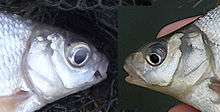Blicca bjoerkna
Blicca bjoerkna, alternatively called the white bream[2] or the silver bream,[1] is a European species of freshwater fish in the family Cyprinidae.
| Blicca bjoerkna | |
|---|---|
| Scientific classification | |
| Kingdom: | Animalia |
| Phylum: | Chordata |
| Class: | Actinopterygii |
| Order: | Cypriniformes |
| Family: | Cyprinidae |
| Subfamily: | Leuciscinae |
| Genus: | Blicca Heckel, 1843 |
| Species: | B. bjoerkna |
| Binomial name | |
| Blicca bjoerkna | |
| Synonyms | |
Distribution
Blicca bjoerkna is distributed across most of Europe and in the adjacent Western Asia. The natural distribution however excludes peripheral areas including northern Sweden, northern Finland and Norway, and most parts of the British Isles (except Southern England) as well as the Iberian and Italian peninsulas. Introduced populations occur also in Spain and Italy, for instance. The Asian distribution is in the Caspian Sea and Aral Sea basins and in Anatolian Black Sea drainages.[2][1]
Description
Bottom, mature silver bream
Small silver bream are very similar in overall appearance to the immature 'common', or 'bronze' bream, Abramis brama, but can be distinguished by the larger scales. Counting the scale rows from the front of the dorsal fin to the lateral line and including the lateral line scale, is the most reliable first step in determining the species. Bronze bream have 13 scales or more, Silver bream 9-11. The lateral line scale count for silver bream is 44-49, while for bronze bream it is 49 and above, and more usually well above 50.
Larger specimens are far easier to discern, because of marked differences in color and body shape. By the time both species attain sexual maturity they become relatively easy to tell apart from one another, the silver bream's scales remaining a bright, highly reflective, silver colour all their lives, whilst the scales of the bronze bream begin to take on a variety of hues, from dark brown to a light ochre yellow, however, some bronze bream do remain a silvery colour all their lives, depending upon habitat. There is confusion when sexually mature silver bream and sexually immature bronze bream are cursorily compared in the field, because bronze bream grow to the same size as sexually mature silver bream very quickly whilst still very young, and when they are almost invariably a silver colour themselves.
The maximum weight a silver bream varies with the habitat quality, but in optimum conditions can be 1.6 kilograms (3.5 pounds). Nevertheless, in normal conditions most silver bream never exceed 0.45 kilograms (1 pound), and in small ponds not even 0.3 kilograms.
The body shape in males and females is subtly different. The female is less compressed than the male, has a rounded form by comparison, and is a little deeper overall, often with a pronounced bulge of the chest. The male is slimmer, and far more compressed. The bulge in the chest is absent, and he may only be two thirds the width of a comparative female of the same length, and consequently weigh far less. The males head is quite pointed and the snout appears slightly upturned, whilst the females head is rounder and with a snub nose. In the breeding season males become covered in tubercles and often display a reddish flush on their bellies and intense vermilion pectoral and ventral fin colouration, whilst all other fins can become very dark and opaque. The females at the same time, can become very rotund and deep set.

Right, immature bronze bream
The eye of a silver bream is very large by comparison with its head, and this character also distinguishes it from the bronze bream as well as from all other European cyprinids apart from the bleak. The eye is round, protruding and with yellowish cornea and black iris. Head length from tip of snout to far extent of gill plate is about 4 times as large as the eye diameter, and head depth is 2.5 times as large, irrespective of the age of the fish. In bronze bream the relationship between eye size and head length changes considerably over the lifetime of the fish, being initially similar to the ratios in silver bream, but in full-grown fish the head length can be as much as 6-7 times eye width and head depth 4-5 times. The measurements are taken along lines bisecting the eye in both directions. The eye is also set very close the end of the snout, and close to the top of the head, but in bronze bream this is far less the case.
Silver bream have light pink to vermilion pectoral and ventral fins. The anal fin is transparent grey to dark grey, as is the deeply forked caudal fin and the dorsal fin. The anal fin has 21-23 branched rays.
Silver bream rarely have mucus on their bodies, and if they ever have, the amount is small. In contrast, bronze bream are often very slimy, especially when young.
References
- "Blicca bjoercna". IUCN Red List of Threatened Species. 2008. 2008. Retrieved 10 May 2012.CS1 maint: ref=harv (link)
- Froese, Rainer and Pauly, Daniel, eds. (2011). "Blicca bjoerkna" in FishBase. August 2011 version.
